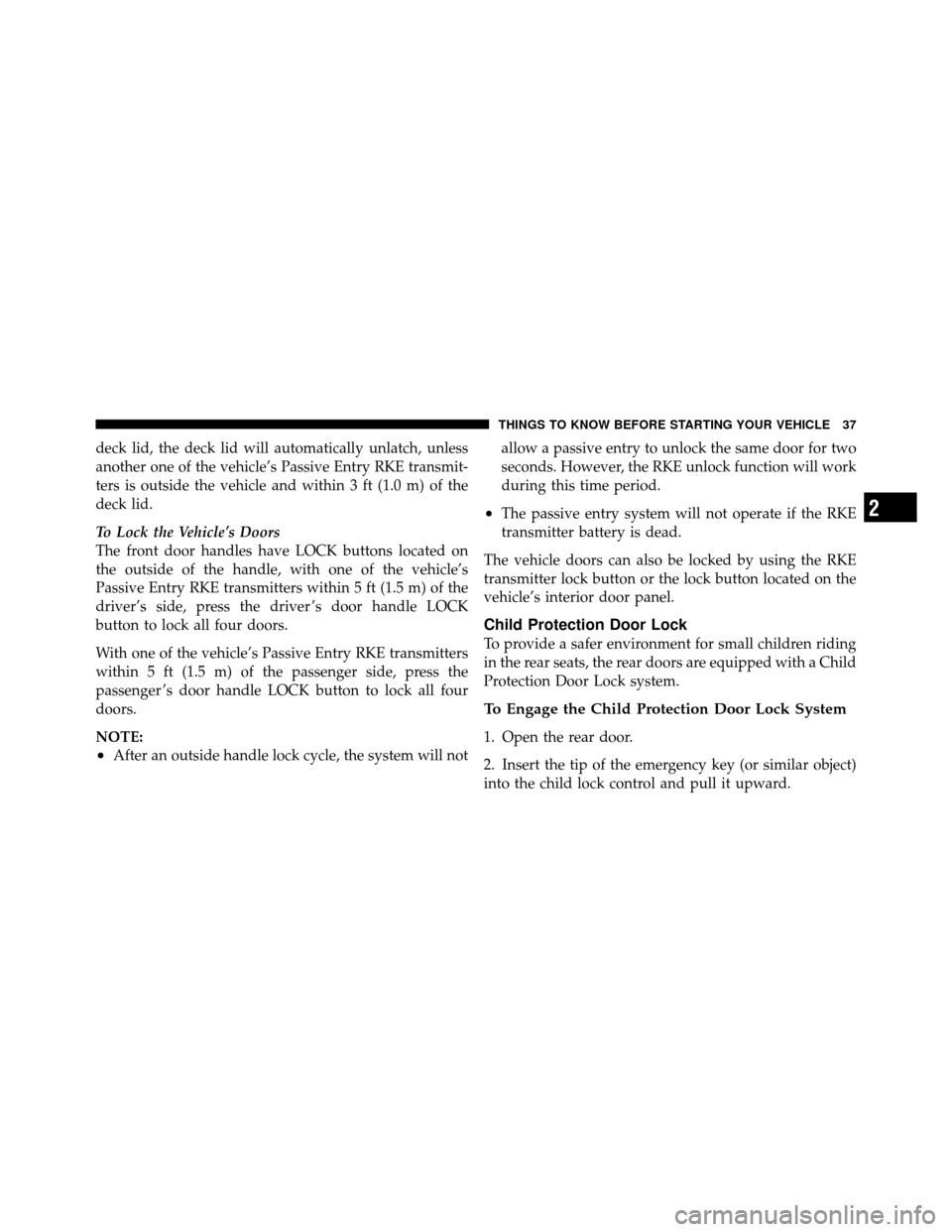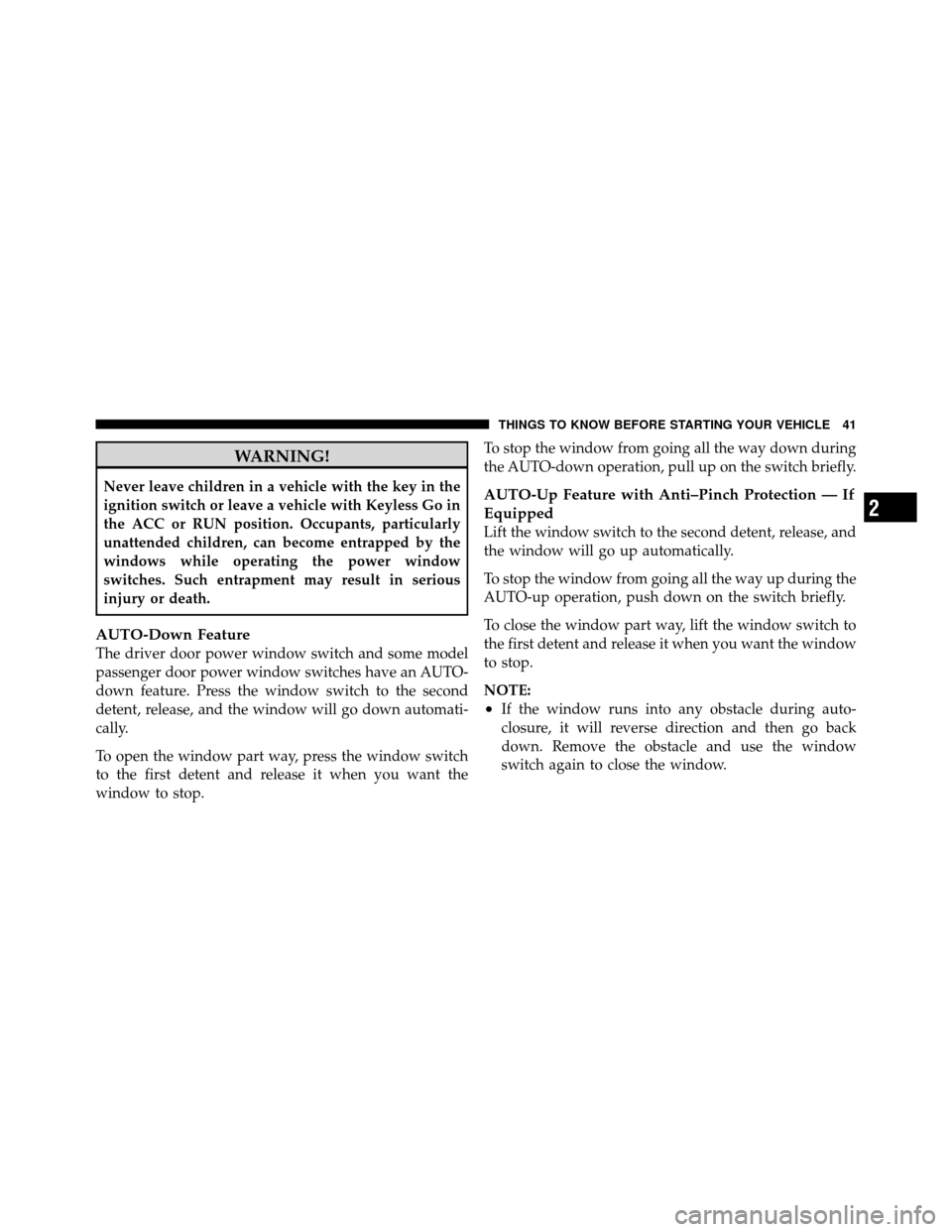Page 38 of 538

deck lid, the deck lid will automatically unlatch, unless
another one of the vehicle’s Passive Entry RKE transmit-
ters is outside the vehicle and within 3 ft (1.0 m) of the
deck lid.
To Lock the Vehicle’s Doors
The front door handles have LOCK buttons located on
the outside of the handle, with one of the vehicle’s
Passive Entry RKE transmitters within 5 ft (1.5 m) of the
driver’s side, press the driver ’s door handle LOCK
button to lock all four doors.
With one of the vehicle’s Passive Entry RKE transmitters
within 5 ft (1.5 m) of the passenger side, press the
passenger ’s door handle LOCK button to lock all four
doors.
NOTE:
•After an outside handle lock cycle, the system will notallow a passive entry to unlock the same door for two
seconds. However, the RKE unlock function will work
during this time period.
•The passive entry system will not operate if the RKE
transmitter battery is dead.
The vehicle doors can also be locked by using the RKE
transmitter lock button or the lock button located on the
vehicle’s interior door panel.
Child Protection Door Lock
To provide a safer environment for small children riding
in the rear seats, the rear doors are equipped with a Child
Protection Door Lock system.
To Engage the Child Protection Door Lock System
1. Open the rear door.
2. Insert the tip of the emergency key (or similar object)
into the child lock control and pull it upward.
2
THINGS TO KNOW BEFORE STARTING YOUR VEHICLE 37
Page 39 of 538
NOTE:For emergency key information, refer to “A
Word About Your Keys”.
3. Repeat Steps 1 and 2 for the opposite rear door. NOTE:
When the Child Protection Door Lock system is
engaged, the door can be opened only by using the
outside door handle even though the inside door lock is
in the unlocked position.
WARNING!
Avoid trapping anyone in a vehicle in a collision.
Remember that the rear doors can only be opened
from the outside when the child protection locks are
engaged. Failure to follow this warning may result in
serious injury or death.
NOTE:
•After engaging the Child Protection Door Lock sys-
tem, always test the door from the inside to make
certain it is in the desired position.Child Lock Control
38 THINGS TO KNOW BEFORE STARTING YOUR VEHICLE
Page 40 of 538
•For emergency exit with the system engaged, move
the door lock plunger to the UNLOCK position, roll
down the window and open the door with the outside
door handle.
To Disengage the Child Protection Door Lock
System
1. Open the rear door.
2. Insert the tip of the emergency key (or similar object)
into the child lock control and pull it downward.3. Repeat Steps 1 and 2 for the opposite rear door.
NOTE:After disengaging the Child Protection Door
Lock system, always test the door from the inside to
make certain it is in the desired position.
Child Lock Control
2
THINGS TO KNOW BEFORE STARTING YOUR VEHICLE 39
Page 42 of 538

WARNING!
Never leave children in a vehicle with the key in the
ignition switch or leave a vehicle with Keyless Go in
the ACC or RUN position. Occupants, particularly
unattended children, can become entrapped by the
windows while operating the power window
switches. Such entrapment may result in serious
injury or death.
AUTO-Down Feature
The driver door power window switch and some model
passenger door power window switches have an AUTO-
down feature. Press the window switch to the second
detent, release, and the window will go down automati-
cally.
To open the window part way, press the window switch
to the first detent and release it when you want the
window to stop.To stop the window from going all the way down during
the AUTO-down operation, pull up on the switch briefly.
AUTO-Up Feature with Anti–Pinch Protection — If
Equipped
Lift the window switch to the second detent, release, and
the window will go up automatically.
To stop the window from going all the way up during the
AUTO-up operation, push down on the switch briefly.
To close the window part way, lift the window switch to
the first detent and release it when you want the window
to stop.
NOTE:
•If the window runs into any obstacle during auto-
closure, it will reverse direction and then go back
down. Remove the obstacle and use the window
switch again to close the window.
2
THINGS TO KNOW BEFORE STARTING YOUR VEHICLE 41
Page 44 of 538

1. Pull the window switch up to close window com-
pletely and continue to hold the switch up for an
additional two seconds after the window is closed.
Wind Buffeting
Wind buffeting can be described as the perception of
pressure on the ears or a helicopter-type sound in the
ears. Your vehicle may exhibit wind buffeting with the
windows down, or the sunroof (if equipped) in certain
open or partially open positions. This is a normal occur-
rence and can be minimized. If the buffeting occurs with
the rear windows open, then open the front and rear
windows together to minimize the buffeting. If the
buffeting occurs with the sunroof open, then adjust the
sunroof opening to minimize the buffeting.
TRUNK LOCK AND RELEASE
The trunk lid can be released from inside the vehicle by
pressing the TRUNK RELEASE button located on the
instrument panel to the left of the steering wheel.NOTE:
The transmission must be in PARK before the
button will operate.
The trunk lid can be released from
outside the vehicle by pressing the
TRUNK button on the Remote
Keyless Entry (RKE) transmitter
twice within five seconds.
With the ignition switch in the RUN position, the Trunk
Open symbol will display in the instrument cluster
indicating that the trunk is open. The odometer display
will reappear once the trunk is closed.
Trunk Release Button
2
THINGS TO KNOW BEFORE STARTING YOUR VEHICLE 43
Page 45 of 538

With the ignition switch in the OFF position or the key
removed from the ignition switch, the Trunk Open sym-
bol will display until the trunk is closed.
Refer to “Passive Entry — If Equipped” under “Door
Locks” in this section for more information on trunk
operation with the Passive Entry feature.
TRUNK SAFETY WARNING
WARNING!
Do not allow children to have access to the trunk,
either by climbing into the trunk from outside, or
through the inside of the vehicle. Always close the
trunk lid when your vehicle is unattended. Once in
the trunk, young children may not be able to escape,
even if they entered through the rear seat. If trapped
in the trunk, children can die from suffocation or
heat stroke.
Trunk Emergency Release
The trunk of your vehicle is equipped with an emergency
release handle. It is located on the inside of the trunk lid,
near the latch, and is coated so that it glows in a darkened
trunk. Pull on the handle to open the trunk.
Trunk Emergency Release
44 THINGS TO KNOW BEFORE STARTING YOUR VEHICLE
Page 64 of 538

ORC deploys the Advanced Front Airbags, SABIC air-
bags — if equipped, and front seat belt pretensioners —
if equipped, as required, depending on the severity and
type of impact.
Advanced Front Airbags are designed to provide addi-
tional protection by supplementing the seat belts in
certain frontal collisions depending on the severity and
type of collision. Advanced Front Airbags are not ex-
pected to reduce the risk of injury in rear, side, or rollover
collisions.
The Advanced Front Airbags will not deploy in all frontal
collisions, including some that may produce substantial
vehicle damage — for example, some pole collisions,
truck underrides, and angle offset collisions. On the other
hand, depending on the type and location of impact,
Advanced Front Airbags may deploy in crashes with
little vehicle front-end damage but that produce a severe
initial deceleration.The side airbags will not deploy in all side collisions. Side
airbag deployment will depend on the severity and type
of collision.
Because airbag sensors measure vehicle deceleration over
time, vehicle speed and damage by themselves are not
good indicators of whether or not an airbag should have
deployed.
Seat belts are necessary for your protection in all colli-
sions, and also are needed to help keep you in position,
away from an inflating airbag.
The ORC monitors the readiness of the electronic parts of
the airbag system whenever the ignition switch is in the
START or RUN position. If the key is in the OFF position,
in the ACC position, or not in the ignition, the airbag
system is not on and the airbags will not inflate.
2
THINGS TO KNOW BEFORE STARTING YOUR VEHICLE 63
Page 67 of 538

Enhanced Accident Response System
In the event of an impact causing airbag deployment, if
the communication network remains intact, and the
power remains intact, depending on the nature of the
event the ORC will determine whether to have the
Enhanced Accident Response System perform the follow-
ing functions:
•Cut off fuel to the engine.
•Flash hazard lights as long as the battery has power or
until the ignition key is turned off.
•Turn on the interior lights, which remain on as long as
the battery has power, until the ignition key is re-
moved or the ignition switch is changed to OFF using
the Keyless Go Start/Stop button.
•Unlock the doors automatically.
If a Deployment Occurs
The front airbags are designed to deflate immediately
after deployment.
NOTE:Front and/or side airbags will not deploy in all
collisions. This does not mean something is wrong with
the airbag system.
If you do have a collision which deploys the airbags, any
or all of the following may occur:
•The nylon airbag material may sometimes cause abra-
sions and/or skin reddening to the driver and front
passenger as the airbags deploy and unfold. The
abrasions are similar to friction rope burns or those
you might get sliding along a carpet or gymnasium
floor. They are not caused by contact with chemicals.
They are not permanent and normally heal quickly.
However, if you haven’t healed significantly within a
few days, or if you have any blistering, see your doctor
immediately.
66 THINGS TO KNOW BEFORE STARTING YOUR VEHICLE